Here at V and F Sheet Metal we consider the difference between sheet metal work and sheet metal fabrication as that between single components and assemblies of more than one component. These assembles may be achieved by simply spot welding two or more sheet metal components, TiG welding thinner gauge sheet metal together or MiG welding thicker gauges of sheet metal or plate. Brazing techniques can still have a place in today’s welding methods although it has been replaced in many instances by TiG welding. I have also included stud welding in this blog post as it does include a form of welding. Sheet metal fabrications and assemblies are used where a single component cannot solve a particular design need. Perhaps several different gauges of metal are needed in one component, water tight joints in a tank, complex features that cannot be bent out of one component or sheet metal components with built in male or female fixing points.
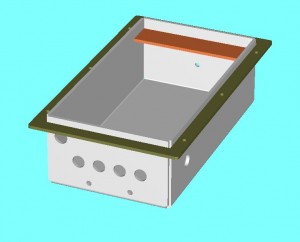
Model of a sheet metal fabrication assembly in Radan software
Sheet metal fabrications modelled in 3D using Radan sheet metal development software. We create these 3D models to help us get the flat developments right so that they can then be CNC bent correctly after being either laser cut or CNC punched. We can also experiment by using the 3D model to see where we can put location points in the actual sheet metal fabrications when we are welding them up in the workshop. These location points may be tags and slots allowing the welder to press the various components together easily and accurately without the need to location jigs or constantly measuring individual part locations to a dimensioned drawing.
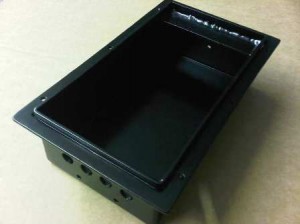
Final sheet metal fabrication
Here you can see the final welded sheet metal fabrication that was modelled above. The 3mm mild steel enclosure was fabricated by using Tig and Mig welding fabrication techniques. Some of the weld joints were cleaned of smooth and some left as they were welded which was specified by the customer. The whole final fabricated assembly has been powder coated black and is now ready for assembly by our customer.
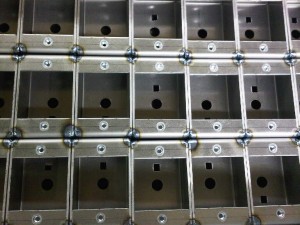
Sheet metal mild steel boxes with tack welded corners
TiG welding doesn’t always have to be used to fuse the corner seams of boxes, tanks or lids but can be used to simply tack weld parts together. Here we have a batch of sheet metal mild steel boxes that we have manufactured for one of our lighting customers. These small track adaptor boxes allow the light fitting to fit to the box and then slide down a ceiling track into any position before being firmly fixed in place. The boxes were fabricated from one piece of mild steel which had been CNC punched and CNC bent with the corners then tack welded together. Once they had been powder coated the joint was virtually invisible.
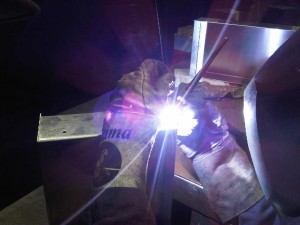
Tig Welding Sheet metal fabrication
There’s not enough space in this blog post to go into minute detail of all the techniques and uses of TiG welding, we do have a web page dedicated to welding fabrication which explains further the TiG welding process. We use TiG welding to fabricate sheet metal assemblies usually out of thinner gauges of metal from say 0.7mm to 3mm in stainless steel alloys, mild steel and aluminium alloys. Leaving MiG welding for fabricating heavier sections, or where a thicker weld is needed and where the finish of the weld isn’t as important but the speed of the weld is. As with all these fabrication welding techniques we are happy to discuss the options you have when looking at your sheet metal fabrication designs.
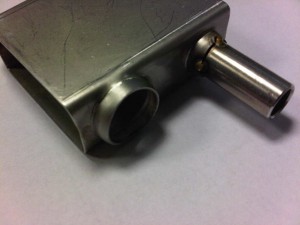
TiG welded stainless steel fabrication
This small 304 stainless steel fabrication has been manufactured from a folded housing and a TiG welded stainless steel tube. The 2 parts have been held together with the tube tack welded perpendicular to the top face of the housing whilst the 3 tack welds were put in place. There is a video you can see on our fly press and press work page of this small stainless steel housing being formed up.

TIG welded mild steel sheet metal fabrication seam joint
A small stainless steel curved angle section has been fabricated from a CNC punched sheet metal section and a rolled sheet metal section. The parts have been tagged together and then had the seam completed TiG welded up. The final welded joint was then cleaned off and powder coated to produce a perfectly smooth invisible joint between the two sheet metal components. This is a typical sheet metal fabrication application and is often used by us to produce complex shapes from more than one sheet metal part in an assembly.
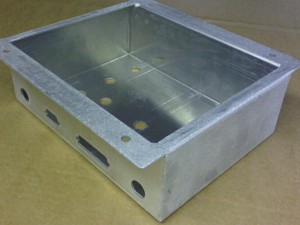
Aluminium Electronics Enclosure
TiG welding sheet metal fabrications doesn’t just have to apply to stainless steel but can also equally be fabricated from aluminium alloys. This electrical enclosure had to have a completely sealed design so seam welded corners was the obviously solution. You can see that once the fabricated joints have been cleaned off smooth and orbital sanded the joint is basically invisible once powder coated.
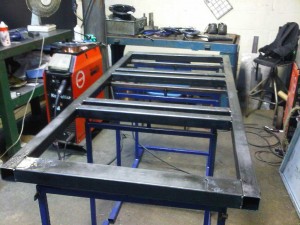
Tubular mild steel MiG welded fabrication
This type of mild steel tubular fabrication is ideally suited to MiG welding. Each tube section has been sawn to length and then loaded into a production jig to align all the joints and ensure the correct sizes are achieved once all the welding has taken place. You can see that the main weld points have then been cleaned off flat so that once the fabrication has been powder coated the faces are ready for assembly. This tubular welded assembly is used to support large electrical cabinets.
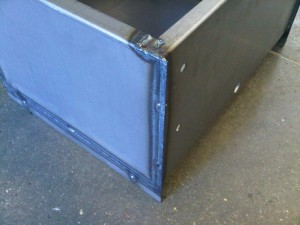
Mild Steel Oil Tank with MiG welded joints
Here a 3mm thick mild steel oil storage tank has been located together by CNC punching slots in some parts and tags in other similar to mortise and tenon joints. Once the tags are pressed into place they are TiG welded to help lock the sheet metal fabrication together. MiG welding is then used to weld all around every joint to seal up any crack from leaking oil. We also use a dye penetrant system after welding to check all the welded joints have no micro cracks before powder coating the final assembly.
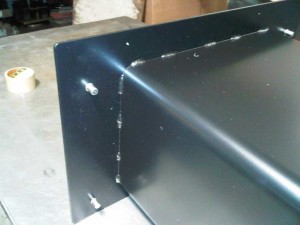
Aluminium fabricated enclosure with TiG welded joints
Here we have used TiG welding to join an aluminium top plate to an enclosure housing. The TiG welding has been used to stitch weld the two parts together. TiG welding is so versatile that the same welding plant can be used for welding either mild steel, stainless steel or aluminium alloys. The final fabrication has been powder coated black ready for the customer to assemble with their electronics.
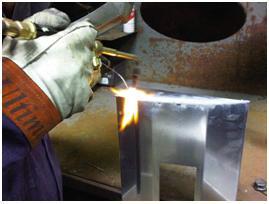
Aluminium brazing an aluminium light fitting
Aluminium brazing sheet metal assemblies is a more skilled process and only used in special circumstances. We would only consider aluminium brazing where TiG welding couldn’t be used first.

Spot welding a Zintec sheet metal fabrication
Spot welding fabrications together as with this Zintec mild steel fan deck assembly is a process that we carry out every week of the year. We have several spot welding machines which enable us to handle a range of materials and thickness without any problems. The spot welding process is good for sheet metal fabrications that don’t need the same strength that fully welding would give and it’s much quicker and cheaper.
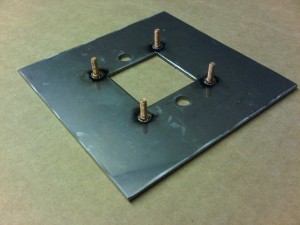
Stainless steel ceiling bezel for down light fitting - rear "stud" face
I thought it was worth including this plate to show the extremes of welding fabrications, stud welding. This simple process allows us to weld males threaded studs and females threaded bushes and standoffs to sheet metal panels. The process is basically welding but in a split second. The stud (in this case) is held off the plate with a stud welding gun and then a pulse of current is applied to the stud and plate at the same time as the gun fires the stud onto the sheet metal plate. There is an instant weld pool and the stud is fixed in place. These studs are used on a light fitting ceiling plate and the stainless steel front face is then highly polished so there is no evidence of the welding process.
For more examples of Sheet Metal Fabrication please follow the link to our Pinterest Boards.
We have only shown a small range of the sheet metal fabrications that we manufacture in our workshops in Fareham, Hampshire. If you have a new fabrication design project and you want some help to decide which fabrication method will be right for you please just pick up the phone or send us an e-mail (sales@vandf.co.uk) with your drawings and we will be happy to help you.